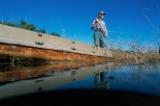Merrymeeting Bay by Beginning with Habitat
At the heart of the Kennebec Estuary is Merrymeeting Bay, one of the most important waterfowl areas in New England. Six rivers, draining one-third of the state of Maine, converge in Merrymeeting Bay to form an inland, freshwater, tidal delta.
Extensive beds of emergent and submerged aquatic vegetation support thousands of ducks, geese, rails, wading birds, and other water-dependent species during spring and fall migrations. Wild rice is common throughout the bay, providing an important food source for migratory waterfowl and other birds such as bobolinks. The intertidal mudflats are also important feeding areas for migrating shorebirds. Floodplain forests and shrub swamps serve as key migratory stopover sites for neo-tropical passerines.
Over 50 species of freshwater fish and ten species of anadromous fish use Merrymeeting Bay, including the rare Atlantic salmon (Salmo salar), shortnosed sturgeon (Acipenser brevirostrum), and Atlantic sturgeon (Acipenser oxyrinchus). At least one rare mussel species, the tidewater mucket (Leptodea ochracea), inhabits the bay. One of the small tributaries flowing into Merrymeeting Bay is Maine’s only known location for the redfin pickerel (Esox americanus). American eels, currently believed to be declining in much of their geographic range, are abundant in parts of the bay.
Merrymeeting Bay has some of the northeast’s best habitat for rare plants associated with tidal freshwater marshes. Several sites around the bay are particularly significant, such as the Cathance River, Chops Creek, Eastern River, Lines Island, Abagadasset Point, and Swan Island.






